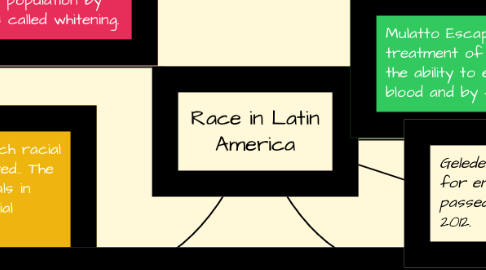Race in Latin America
by niko mann


1. Chinese Coolies. After the abolition of slavery, cheap labor was needed for plantations in Cuba and Peru. Chinese labor were brought in under contracts, however the human rights violations and racism were similar to slavery.
1.1. Maths
1.1.1. Text book, exercises 34, 35, 36, 37
2. Brazil transported 10 to 12 times more Africans to slave plantations than the US.. There were no anti-segregation and anti-miscegenation laws like the US. Their goal was to lighten the black population by breeding them out with the Europeans in a process called whitening.
2.1. Spanish
2.1.1. New vocabulary
3. Racial Formation Theory the sociohistorical process by which racial categories are created, inhabited, transformed, and destroyed.. The outcomes of a racialized social structure where differentials in wealth, income, and assets shape what we believe about racial categories.
3.1. Physics
3.1.1. Research and prepare experiment
4. The Mapuche native people of Chili fight to keep their forests and protest against police violence. The Guarani are a quiet and spiritual people with similar land struggles in Brazil, Paraguay, Bolivia, Uruguay, and Argentina, with leaders being assassinated, and children starving. The Zapatista Army of National Liberation in Mexico has fought since 1994 for the rights of the indigenous population. Gaspar Yanga was a leader of the slave rebellion in Mexico during the time of Spanish colonial rule in town of Pueblito. Now there are almost no black people in the town. All have been pushed out to poor areas where most of the dark skinned people are forced to live. They have no economical power. The Pacific Coastal region of Columbia has an 80-90 percent black population and live in extremely underdeveloped conditions. The ongoing theme in Latin America is that the darker your skin is, the more you are degraded by society.
4.1. English
4.1.1. Text book p. 55-60
4.1.2. Joseph Conrad "Heart of Darkness"
4.2. Mapuche native people fight to keep forests and protest against police violence Guarani are a quiet and Spiritual people with land struggles Brazil, Paraguay, Bolivia, Uruguay, and Argentina with leaders being assassinated, and children starving. The Zapatista Army of National Liberation In 1994, the Zapatista Army revolted against the Mexican Army.
5. Mulatto Escape Hatch is a reference to Brazil's better treatment of Blacks with white blood and lighter skin. and the ability to escape racism by procreating with European blood and by financial gain.
5.1. Spanish
5.1.1. Midterm
